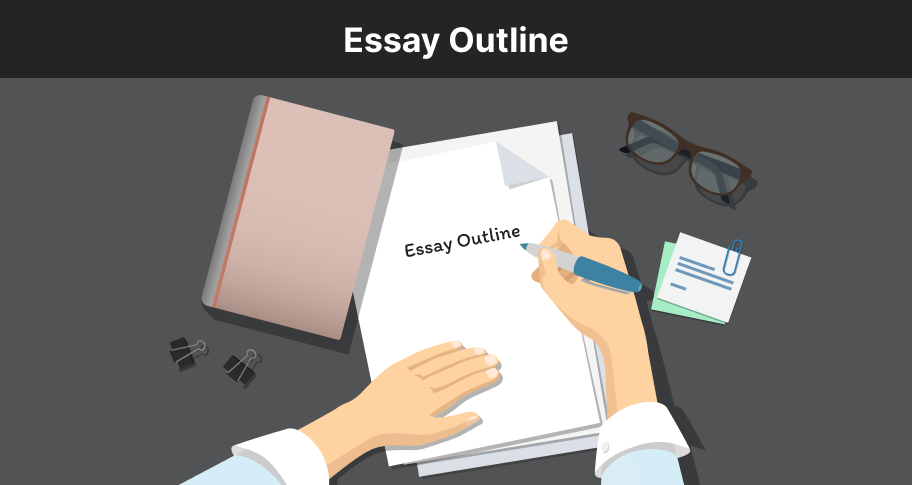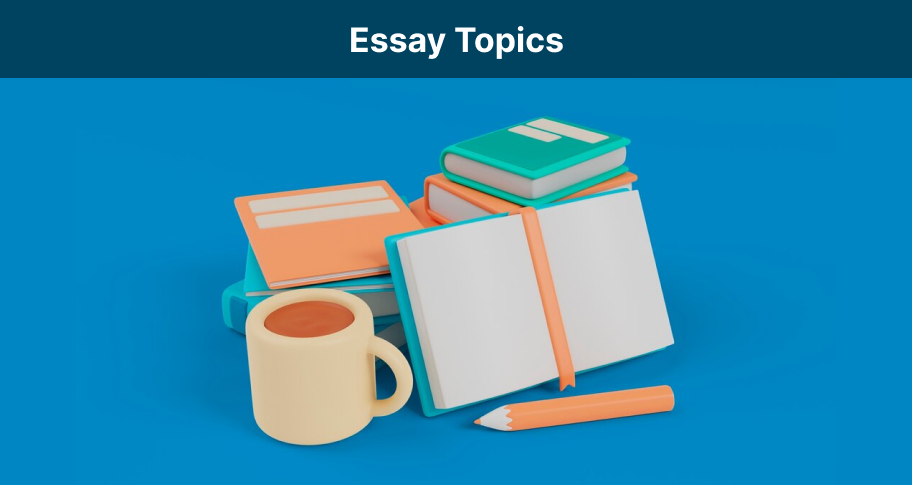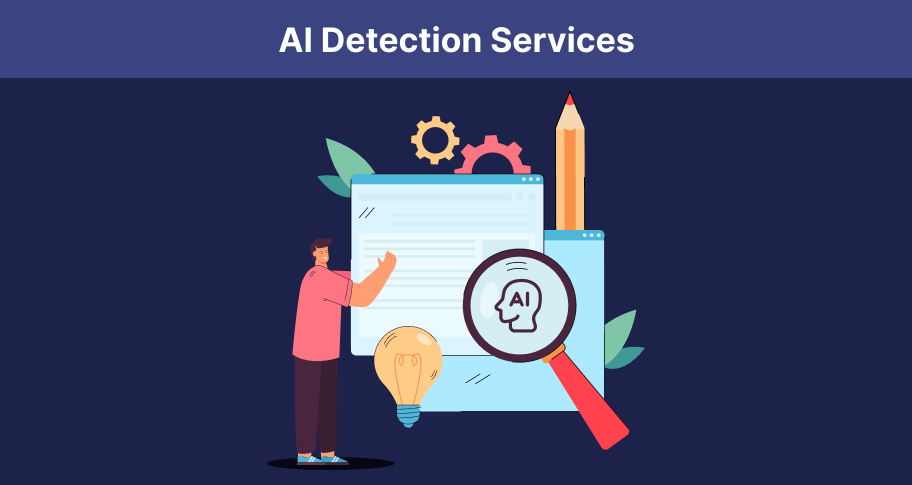Introduction
What sometimes seems like the chore can turn out to be your biggest help in making your essays and term papers stand out.
If you want to improve your writing and get better grades, it is always a good idea to learn how to write good essay outlines.
What is an Essay Outline?
An essay outline is a structured plan that serves as a roadmap for your writing. It organizes your thoughts and ideas in a clear and logical manner before you begin writing, so that your essay has structure, is coherent and lets you effectively communicates your argument. A well-crafted outline allows you to maintain focus on the thesis and supports the clarity of the essay’s message, which makes the writing process smoother.
- An essay outline is the skeleton of your essay, research paper, or term paper.
- An essay outline is a road map and guide, but one that you create yourself.
When you write an essay, you start from scratch, with nothing but a jumble of thoughts. The outline is what helps you assemble the parts and put them together in a way that makes sense.
If you have trouble writing your essays, try spending a lot more time writing your outline. You will find that your writing flows a lot easier when you write an essay outline first.
A good outline will lead to a better essay.
Importance of Creating an Outline
Creating an outline before writing an essay offers numerous advantages. It helps in organizing thoughts, avoiding writer’s block, and improving the overall flow of the essay. An outline lets you see that all key points are covered. It helps the writer stay focused on the thesis and the main arguments. Moreover, an outline serves as a guide that keeps the essay on track, so that the writer doesn’t stray off-topic or forget to include important details.
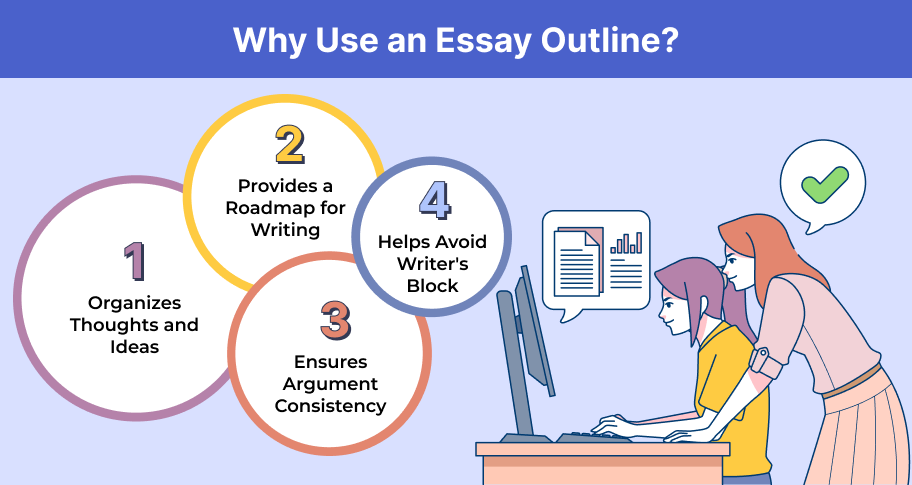
Want Writing to Be Painless?
Writing an essay outline is easy, and only takes up a little bit of your time. An essay outline also gets you more in the habit of thinking differently about scholarly writing.
When you regularly write essay outlines, you will find that your overall essay writing quality improves considerably. That’s because outlines give you the mental muscle to zero in on your topic. Outlines also help you write essays faster. A little extra time up front can save you a whole lot of time down the road.
The more you get used to writing outlines, the more painless your overall writing process will become!
View 120,000+ High Quality Essay Examples
Learn-by-example to improve your academic writing
Steps to Create an Essay Outline
Step 1: Understand Your Topic and Thesis
Before starting your outline, it helps to have a clear understanding of your topic. Clarity is what allows you to formulate a strong thesis statement. The clearer you see things, the more direct you can be.
The thesis is the main point. It serves as the foundation of your essay, guiding the direction of your arguments. To narrow down the focus, consider what aspect of the topic interests you the most or what specific argument you want to make. For example, if your topic is WW2, your thesis might focus on the rise of Communism vs. Fascism in Europe as a prelude to war.
Step 2: Gather and Organize Information
Once you have your topic and thesis, the next step is to gather relevant information and organize it logically. Group similar ideas together, and decide the most logical sequence for presenting your arguments. You can categorize information by themes, chronology, weight of the evidence, or importance of argument. This step is essential in creating a well-organized and easy to follow essay.
- Categorizing by Themes: When you group information by themes it is easier to present ideas in a coherent manner. For example, if you are writing an essay on WW2, you might categorize your information into themes like “causes of the rise of Fascism,” “effects of the spread of Communism,” and “major Communist and Fascist figures.” This method helps in structuring your essay in a way that each section logically flows into the next. The end result is that your arguments are more compelling and easier to follow.
- Organizing Chronologically: When dealing with topics that have a historical or procedural nature, organizing your information chronologically can also be effective. For example, if your essay is about the development of artificial intelligence, you might want to arrange your points starting from the early days of AI research to the latest advancements. This way you have a clear timeline that helps the reader to understand the evolution of your topic over time.
- Prioritizing by Weight of Evidence: Another strategy is to organize information based on the strength or credibility of the evidence. One way to do it is to start with the most compelling evidence to build a strong foundation for your argument, and then present supporting or supplementary evidence. Or you can do just the opposite, start with lesser evidence and build to the biggest, most impressive evidence to conclude with a powerful impact.
- Importance of Argument: Finally, you might choose to structure your outline by the importance of each argument. This can be particularly useful in persuasive or argumentative essays. This approach is like playing cards—you don’t tip your hand right away but rather save the best for last.
Step 3: Structure Your Outline
A well-structured outline typically includes an introduction, body paragraphs, and a conclusion.
- Introduction: Start with a hook to grab the reader’s attention, provide some background information on the topic, and end with a clear and concise thesis statement.
- Body Paragraphs: Each body paragraph should focus on a single argument or point, supported by evidence. Include counterarguments where necessary, and explain how they strengthen your thesis.
- Conclusion: Restate the thesis and summarize the main points of the essay. Draw connections back to the introduction to reinforce your argument.
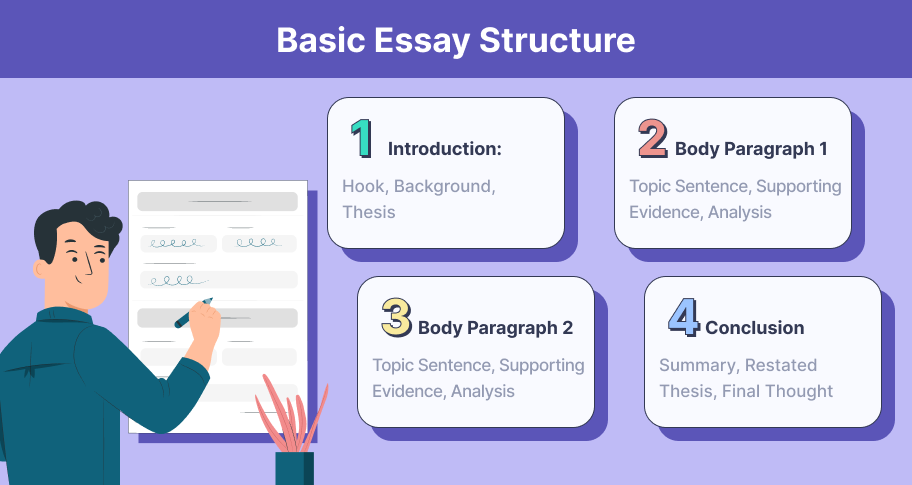
Common Outline Structures
Alphanumeric Outline
The alphanumeric outline is the most common type of outline used in academic writing. It uses Roman numerals, capital letters, Arabic numerals, and lowercase letters to organize ideas in a hierarchical structure. For example:
I. Introduction
A. Hook
B. Background Information
C. Thesis Statement
II. Body Paragraph 1
A. Main Argument
B. Supporting Evidence
1. Evidence 1
2. Evidence 2
III. Conclusion
A. Restate Thesis
B. Summarize Main Points
C. Final Thought
Here’s an example of how a basic outline using the alphanumeric method would look if the essay were about the some of the different types of life on the planet:
I. Plants
A. Trees
1. Oak
2. Banyan
B. Flowers
1. Tulips
2. Roses
II. Animals
A. Reptiles
1. Turtles
2. Snakes
3. Lizards
B. Mammals
1. Rodents
a. Bats
b. Rats
With this alphanumeric system of outlining, each upper-level (I, II, III) tier is the broadest category, and within each broad category you can include several sub-categories.
There are of course other ways to outline your essay, so don’t feel obliged to stick with this one. However, because the vast majority of instructors will ask you to create a formal essay outline from time to time, it is best to master this method now.
Decimal Outline
The decimal outline is an alternative method of structuring an outline, where each section is numbered using a decimal system. This format is especially useful for complex outlines where sub-points are numerous and need to be clearly distinguished.
-
- Introduction 1.1. Background Information 1.2. Thesis Statement 1.3. Overview of Main Points
- Body Paragraph 1: The Impact of Social Media on Mental Health 2.1. Negative Effects on Adolescents 2.1.1. Increased Anxiety and Depression 2.1.2. Cyberbullying and Its Consequences 2.2. Positive Uses of Social Media 2.2.1. Support Networks and Online Communities 2.2.2. Access to Mental Health Resources
- Body Paragraph 2: The Role of Social Media in Education 3.1. Enhancing Learning Opportunities 3.1.1. Online Courses and Webinars 3.1.2. Collaborative Learning through Social Media 3.2. Challenges in Using Social Media for Education 3.2.1. Distraction and Procrastination 3.2.2. Misinformation and Credibility Issues
- Conclusion 4.1. Summary of Key Points 4.2. Restatement of Thesis 4.3. Final Thoughts on the Future of Social Media
Full Sentence vs. Topic Outlines
In a full sentence outline, each point is expressed as a complete sentence, providing a more detailed overview of the essay’s content. A topic outline, on the other hand, uses brief phrases or keywords to summarize each point. The choice between these two depends on the complexity of the essay and the writer’s preference.
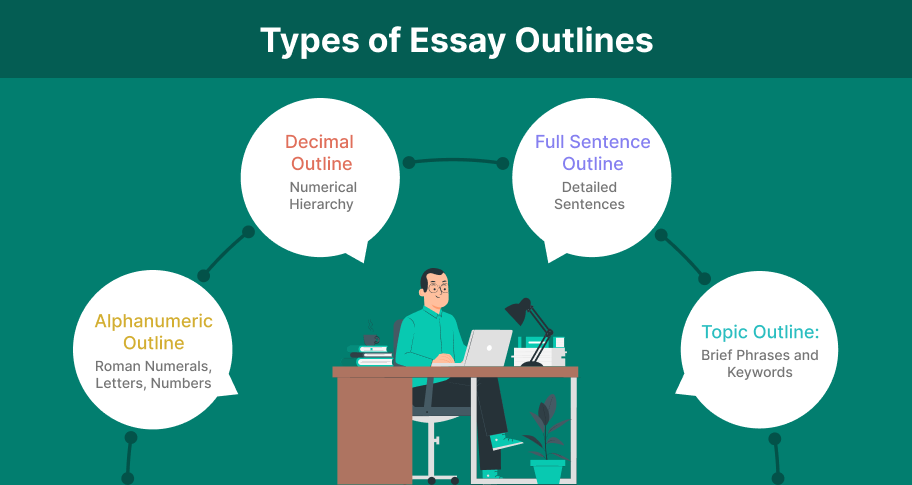
Examples of Essay Outlines
By Essay Type
- Argumentative Essay Outline: Introduce the issue, present arguments and counterarguments, and conclude by restating the thesis and summarizing the arguments (See example below)
- Expository Essay Outline: Provide background information, explain the topic, and conclude by summarizing the main points.
- Literary Analysis Essay Outline: Break down the literature into themes, characters, or plot points, and analyze each in detail (See below for example)
- Persuasive Essay Outline: Introduce the issue, present evidence supporting your viewpoint, and conclude with a call to action.
By Subject
- Literature: Analyze a piece of literature, focusing on themes, characters, or literary devices.
- History: Discuss a historical event, examining its causes, effects, and significance.
- Science: Explain a scientific concept or phenomenon, detailing its implications and applications.
- Social Issues: Explore a social issue, discussing its causes, effects, and potential solutions.
By Topic
- The Impact of Social Media on Mental Health: Discuss the positive and negative effects of social media on mental health, supported by research and statistics.
- The Benefits and Drawbacks of Technology in Education: Analyze the role of technology in education, highlighting both the advantages and potential drawbacks.
- Climate Change and its Effects: Examine the causes and effects of climate change, discussing possible solutions to mitigate its impact.
- The Importance of Diversity and Inclusion: Discuss the significance of diversity and inclusion in various contexts, supported by examples and research.
Argumentative Essay Outline
Have you been asked to write an argumentative essay?
An argumentative essay is exactly what it sounds like: an essay in which you take a strong stance on an issue.
Ever get into an argument with your friends or parents, or someone online? Just think of this as the groundwork for starting your argumentative essay.
An argumentative essay can be short or long, but ultimately, you will be arguing with an imaginary companion.
Pretend you are arguing with your instructor when you are writing an argumentative essay and your outline will look like this:
I. Introduction
A. Hey! Let’s talk about this issue. This issue is important because people are suffering.
B. You might believe this to be true, but when you examine the evidence you might come to change your mind.
C. My thesis statement is that my position is correct because of x, y, and z.
II. Body Paragraph One
A. The first reason why I am correct about this issue is that there is research backing up what I believe.
B. The research states:
1. Insert paraphrase, quote, or citation here.
2. Discuss and reflect on the paraphrase, quote, or citation
C. Because of this, I am correct.
III. Body Paragraph Two
A. The second reason why I am correct about the issue is…
IV. Body Paragraph Three
A. The third reason why I am correct about the issue is…
V. Body Paragraph Four
A. Let’s talk about your point of view.
B. You believe this because….
1. Reason one
2. Reason two
C. Here is why you are wrong.
1. Reason one is wrong because…
2. Reason two is wrong because…
VI. Conclusion
A. Let’s go over my thesis statement again
B. The reasons why I am right are x, y, and z.
Literary Analysis Essay Outline
I. Introduction
A. Hook: Begin with a quote about the relevance of “To Kill a Mockingbird”.
B. Background Information: Provide a brief overview of the novel: setting, main characters, and central conflicts.
C. Thesis Statement: Introduce the main argument of the essay, focusing on how the novel’s themes, characters, and plot points reveal deeper meanings about race, sex, and justice.
II. Theme Analysis: Racial Injustice
A. Representation of Racism in Maycomb: Discuss how the setting of Maycomb, Alabama, serves as a microcosm for the racial tensions in the American South.
B. The Trial of Tom Robinson: Analyze how the trial exemplifies the theme of racial injustice and the inherent bias within the legal system.
C. Impact on the Characters: Examine how characters like Atticus Finch, Scout, and Tom Robinson respond to and are affected by the pervasive racism in their community.
III. Character Analysis: Moral Growth
A. Scout’s Journey from Innocence to Understanding: Explore Scout Finch’s character development as she navigates the complexities of morality and justice.
B. Atticus Finch as a Moral Compass: Analyze Atticus Finch’s role as a moral guide for both his children and the community, emphasizing his unwavering commitment to justice and equality.
C. Jem’s Coming-of-Age: Discuss Jem Finch’s growing awareness of the world’s imperfections and how this shapes his understanding of morality.
IV. Plot Analysis: The Loss of Innocence
A. The Mockingbird Symbolism: Explain how the symbolism of the mockingbird represents the loss of innocence and the destruction of purity.
B. Key Events Leading to the Loss of Innocence: Analyze pivotal moments in the novel, such as the trial, Boo Radley’s interactions with the children, and the final confrontation, that contribute to the theme of lost innocence.
C. The Transformation of Boo Radley: Discuss how Boo Radley’s character evolves from a figure of fear to a symbol of goodness and protection, reflecting the theme of innocence lost and regained.
V. Conclusion
A. Restate Thesis: Reiterate how Harper Lee’s exploration of racial injustice, moral growth, and the loss of innocence provides a nuanced understanding of human behavior.
B. Summarize Main Points: Briefly summarize the key points discussed in the analysis.
C. Final Thought: Conclude with a reflection on the novel’s lasting impact on readers and its relevance in contemporary discussions about race, morality, and justice.
Persuasive Essay Outline
I. Introduction
A. Hey! There is a very important issue that you have no knowledge of yet, and I would like for you to take action.
B. did you know that a,b,c are true?
C. Thesis: You should vote a certain way or do a certain something because of a,b,c.
II. Body Paragraph One
A. Consider issue (a), and how your contributions or change in worldview might help solve the problem.
B. Here is some scientific evidence showing that if you take action, you can solve the problem.
C. Let’s move onto the next issue.
III. Body Paragraph Two
A. Consider issue (b) and how your contributions or change in worldview can help solve the problem.
B. Here is some academic or scholarly evidence supporting my view.
C. Here is what you can do.
IV. Body Paragraph Three
A. If you do nothing, this could happen.
B. It is important to consider other options, but I sincerely believe that my way of doing this is best because:
1. Reason
2. Reason
V. Conclusion
A. I hope I have persuaded you that killing animals is wrong, or that saving the whales is right.
B. I have presented evidence to you such as a,b,c
C. We’re all in this together, let’s take action!
Compare and Contrast Essay Outline
A compare and contrast essay outline is a little bit different from other types of essay outlines.
For one, there are two different types of compare and contrast essays. The first is the block format. The second is the point-by-point format.
With the block format, you discuss one issue at a time.
With the point-by-point format, you discuss points of similarity and difference one at a time.
Either way, you have an introduction, body, and conclusion.
Block Format Compare and Contrast Essay Outline
I. Introduction
II. Discuss Item 1
A. Detail 1
B. Detail 2
III. Discuss Item 2
A. Detail 1
B. Detail 2
IV. Discuss Similarities and Differences
V. Conclusion
Point-By-Point Format Compare and Contrast Essay Outline
I. Introduction
II. First point of comparison
III. Second point of comparison
IV. Third point of comparison
V. Conclusion
Informative Essay Outline
Sometimes you will be called upon to write an informative essay. Unlike argumentative or persuasive essays, an informative essay does not require that you have a strong opinion on the issue. In fact, your goal is to remain as objective as possible in your tone.
Informative essay topic examples include:
- Country or geography profiles
- Information about a specific food or drink
- A company report
Informative essays read like news articles, informing the reader about who, what, when, where, why, and how.
An informative essay outline would be completed according to the principles of the five-paragraph essay.
I. Introduction
A. On December 4, 2018 there was an earthquake in Jones, Alabama
B. The earthquake has impacted the availability of some community services, electricity and running water, and relief efforts.
II. Issue One: Community services.
A. Libraries and schools will remain shut all week.
B. The buses are running a limited schedule.
III. Issue Two: Utilities
A. Electricity is back on for some, but not all residents.
B. Running water is on for 90% of residents, and all others are asked to remain at the county shelters.
IV. Issue Three: Relief efforts.
A. Rescue and relief operations are currently taking place in remote areas.
B. Hospital services are restricted only to essential and emergency interventions.
V. Conclusion
A. You can find out more information on this website.
Explanatory Essay Outline
An essay that explains how to do something, or which explains a specific problem or situation is called an explanatory essay.
When you write an explanatory essay, the goal is to answer questions like:
Why does this happen?
How does this thing work?
Topic examples for an explanatory essay include:
- Explain how a food chain works in a wetland ecosystem
- Explain how a bill becomes a law.
- Explain how a college graduate finds a job.
An explanatory essay outline would look like this:
I. Introduction
A. What is it you are going to explain?
B. How are you going to explain it?
C. Thesis: The main components include a,b,c.
II. The first step
III. The second step
IV. The third step
V. Conclusion
Synthesis Essay Outline
Although not as often assigned as argumentative essays, synthesis essays can be common in certain courses like art and literature.
The term “synthesis” means to combine or join together. When you write a synthesis essay, you are blending various ideas or concepts. For example, you might want to synthesize different points of view on a political issue, or synthesize various art critics’ opinions of a certain piece.
Writing an outline can greatly help you write a synthesis essay, keeping your thoughts and ideas focused.
Using the template of the five-paragraph essay outline, you can create a strong synthesis essay outline as follows:
I. Introduction
A. Policy analysts/art historians/literary critics like to discuss this issue because…
B. Some scholars, like this person, believe…
C. Other scholars, like these people, believe…
D. Thesis: These various viewpoints link together and share a common ground on these three main elements: x, y, and z.
II. Theory one
III. Theory two
IV. How theories intersect with one another.
V. Conclusion
Cause and Effect Essay Outline
You will often be asked to write about the causes and effects of a war, political situation, disease, or just about anything else you can think of.
A cause and effect essay usually tends to focus on one or the other: on causes or effects. In some cases, though, you might be able to discuss both in the same essay.
For example, you could say that the causes of Type II Diabetes is lifestyle-related, and that the effects of Type II Diabetes include fatigue, vision problems, and reduced overall quality of life.
If you are focusing on both causes and effects, your essay outline might look like this:
I. Introduction to the issue
A. What is the big deal about this particular issue and why is it important to understand its causes and effects?
B. Thesis: The causes of the issue are…and the effects are…
II. Causes
A. Cause 1
B. Cause 2
III. Effects
A. Effect 1
B. Effect 2
IV. Conclusion
If you are only focusing on the causes, your outline would look more like this:
I. Introduction to the issue
A. Why is understanding what caused this issue so important to understand?
B. The issue is caused by x,y, and z
II. Cause 1
III. Cause 2
IV. Cause 3
V. Conclusion
Now we know what causes this problem, it might be easier to look for solutions.
If you are only focused on the effects, your essay outline would look like this:
I. Introduction to the issue
A. Why is this topic so important to understand?
B. The effects of this include x,y,z
II. First effect
III. Second effect
IV. Third effect
V. Conclusion
View 120,000+ High Quality Essay Examples
Learn-by-example to improve your academic writing
Process Essay Outline
Have you ever been asked to explain how to do something, such as writing a recipe? A process essay is one in which you explain to the reader how something is done or achieved in a step-by-step method.
A process essay outline looks like this:
I. Introduction
II. The first steps in the process
III. The next steps
IV. The final steps
V. Conclusion
Rhetorical Analysis Essay Outline
What is a rhetorical analysis?
A rhetorical analysis essay is one in which you thoroughly analyze another person’s argument. Usually, you will be asked to critique a certain author. Rhetorical analysis assignments are common.
Typical examples of a rhetorical analysis include:
- Analyzing Martin Luther King, Jr.’s “Letter From Birmingham Jail” in terms of pathos, ethos, and logos.
- Analyzing Jonathan Swift’s “A Modest Proposal”
- Analyzing a presidential speech
A rhetorical analysis essay outline looks like this:
I. Introduction
A. Introduce the speech, work of art, or literature
B. The author/artist uses ___ techniques to achieve ___ goals.
II. Technique one
A. The author uses this technique to achieve the main goals.
B. Citations from the primary source
III. Technique two
A. The author uses this technique to achieve the main goals.
B. Citations from the primary source
IV. Technique three
A. The author uses this technique to achieve the main goals.
B. Citations from the primary source
V. Conclusion
A. The author did or did not achieve ___ goals through the use of ___ techniques
Compare and Contrast Essay Outline
I. Introduction
A. Zombies and vampires are two “undead” creatures that have captivated the public consciousness.
B. Thesis: Although zombies and vampires are both undead enemies of the living, they have different etiologies, different characteristics, and different needs and motivations.
II. Etiology/Origins
A. The etiology of zombie-ism is either an infection or a curse.
1. West African religions and Voodoo tend to view zombie-ism as a result of a curse, which can be imposed upon others by a witch or black magician.
2. There are also herbs and potions that can cause catatonia or physical states that mimic death, creating a “living dead” person.
3. Modern zombie literature frequently refers to outbreaks or infections, framing zombie-ism more as a disease.
B. The etiology of vampirism is direct transmission from one vampire to another.
III. Characteristics
A. Zombies are mindless, soulless wanderers, whereas vampires are soulless, but they are highly intelligent creatures with active social lives.
B. Vampires tend to have a certain elegance in their demeanor, whereas zombies cannot hold a conversation at all.
C. Both zombies and vampires have senses that are honed to find human prey.
D. Vampires have an aversion to daylight, but most types of zombies do not.
IV. Needs and Motivations
A. Both zombies and vampires are selfishly motivated by their own perpetual hunger.
B. Both zombies and vampires also have a desire to propagate their own species by transforming human beings into one of them.
V. Conclusion
A. Zombies and vampires are both undead, but they look and act different from one another.
B. If there was an apocalyptic battle between zombies and vampires, it is uncertain who would win, but it is certain that the living would lose.

Common Pitfalls in Essay Outlining
When creating an essay outline, it’s easy to fall into certain traps. Common mistakes include over-complicating the outline, which can make it difficult to follow; failing to stay aligned with the thesis, leading to a disjointed essay; and writing overly detailed outlines, which can be more time-consuming than helpful. It’s important to keep the outline concise and focused—otherwise it won’t be a very good guide when it comes time to writing the essay.
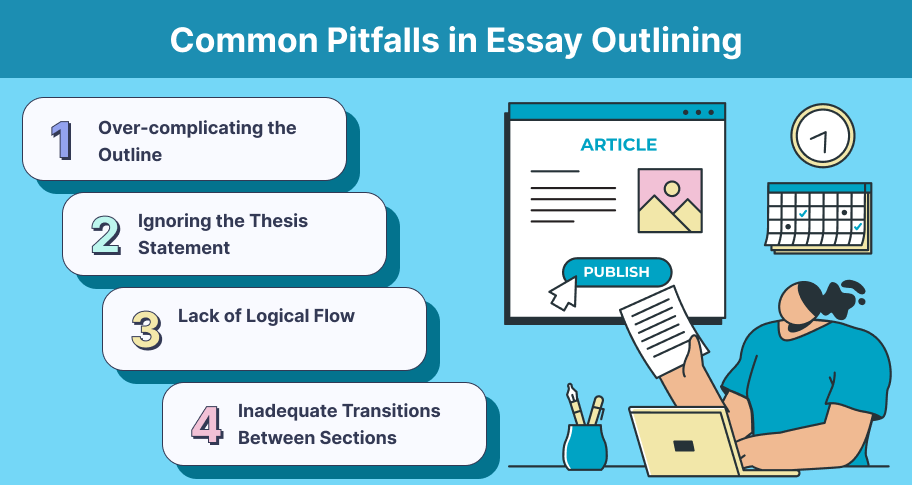
Tips for Effectively Using an Outline
To make the most of your outline, regularly refer back to it to make sure that your essay remains on track. If you find that your essay is going in a different direction, stop and think about if this makes sense for your overall thesis. If so, revise your thesis and your outline. Don’t just wing it in a new direction. Stop, and plan it out first.
Conclusion
An essay outline is one more tool in your writing tool bag. Use it to organize your thoughts. The outline lets you see what points you can cover, and it is a good guide when you start writing because it shows you what points to tackle. Follow the steps outlined above and avoid the common pitfalls, and you will be able to create an effective outline that will greatly improve your writing. It’s the little steps that add up to make high quality essays!
- Creating an outline is one of the most important parts of the process of writing essays and term papers.
- Like a good road map for your ideas, an essay outline helps you stay focused on your writing goals.
- An essay outline includes all the main components of the essay including the introduction, the body, and the conclusion.
- You can always download our free essay outline template / worksheet to help assist you as well.

